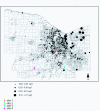Case control study of the geographic variability of exposure to disinfectant byproducts and risk for rectal cancer
- PMID: 17535441
- PMCID: PMC1890278
- DOI: 10.1186/1476-072X-6-18
Case control study of the geographic variability of exposure to disinfectant byproducts and risk for rectal cancer
Abstract
Background: Levels of byproducts that result from the disinfection of drinking water vary within a water distribution system. This prompted us to question whether the risk for rectal cancer also varies, depending upon one's long term geographic location within the system. Such a geographic distribution in rectal cancer risk would follow naturally from an association between level of byproduct and rectal cancer risk. We assess the effects of estimated geographic variability in exposure to some of the components of the trihalomethane group of disinfectant byproducts (DBPs) on the odds ratios and probabilities for rectal cancer in white males in a case control study of 128 cases and 253 controls, conducted in Monroe County, Western New York State, U.S.A. The study was designed around health data initially collected at the University at Buffalo (Department of Social and Preventative Medicine) as part of the Upstate New York Diet Study, and trihalomethane (THM) data collected from a separate independent study of THMs conducted by Monroe County Department of Health. Case participants were chosen from hospital pathology records. The controls are disease-free white males between 35-90 years old, living in Monroe County, and chosen from control groups for studies from cancer of five other (unrelated) sites. Using a combination of case control methodology and spatial analysis, the spatial patterns of THMs and individual measures of tap water consumption provide estimates of the effects of ingestion of specific amounts of some DBPs on rectal cancer risk. Trihalomethane (THM) data were used to spatially interpolate levels at the taps of cases and controls, and odds ratios were estimated using logistic regression to assess the effects of estimated THM exposure dose on cancer risk, adjusting for alcohol, dietary beta carotene intake, tap water intake, and total caloric intake.
Results: Trihalomethane levels varied spatially within the county; although risk for rectal cancer did not increase with total level of trihalomethanes, increasing levels of the component bromoform (measured in ug/day) did correspond with an increase in odds ratios (OR = 1.85; 95% CI = 1.25 - 2.74) for rectal cancer. The highest quartiles of estimated consumption of bromoform (1.69-15.43 ug/day) led to increased risk for rectal cancer (OR = 2.32; 95% CI = 1.22-4.39). Two other THMs were marginally associated with an increase in risk - chlorodibromomethane (OR = 1.78, 95% CI = 1.00-3.19) and bromodichloromethane (OR = 1.15; 95% CI = 1.00-1.32).
Conclusion: Levels of THMs in the water distribution system exhibited spatial variation that was partially due to variation in water age. We also observed a geographic pattern of increased risk of rectal cancer in areas with the highest levels of bromoform in the county.
Figures




References
-
- Parkin DM, Bray F, Farlay J, Pisani P. Global Cancer Statistics, 2002. CA Cancer J Clin. 2005;55:74–108. - PubMed
-
- Devesa SS, Grauman DG, Blot WJ, Pennello G, Hoover RN, Fraumeni JF., Jr . Atlas of Cancer Mortality in the United States, 1950–94. Washington, DC: US Government Printing Office; 1999. NIH Publication No. 9-4564.
-
- Freudenheim JL, Graham S, Marshall JR, Haughey BP, Wilkeson G. A case-control study of diet and rectal cancer in Western New York. Am J Epidemiol. 1990;131:612–624. - PubMed
Publication types
MeSH terms
Substances
Grants and funding
LinkOut - more resources
Full Text Sources
Miscellaneous

